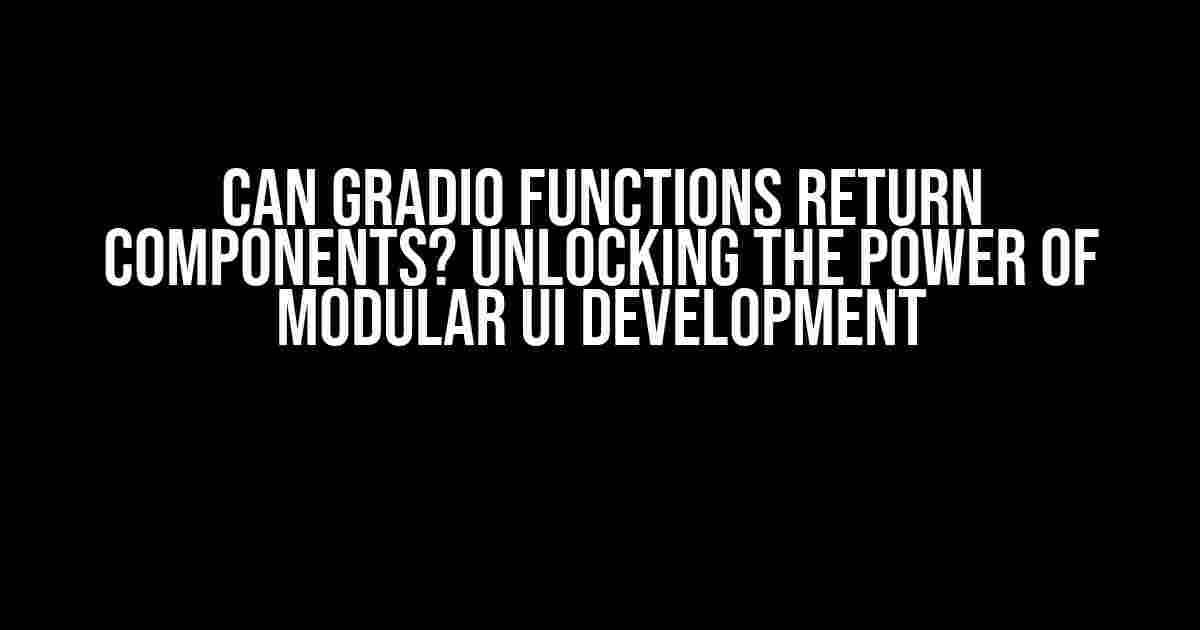Are you tired of cluttered code and tedious UI development? Look no further! Gradio, the popular Python library, offers a game-changing feature that can revolutionize the way you build and deploy user interfaces. In this article, we’ll dive into the world of Gradio functions and explore the magic of returning components. Buckle up and get ready to unlock the full potential of modular UI development!
What are Gradio Functions?
Before we dive into the main event, let’s take a step back and review what Gradio functions are. In Gradio, a function is a self-contained block of code that performs a specific task. Think of it as a mini-program that takes input, processes it, and returns a result. Gradio functions can be used to build complex UI components, interact with external systems, or even perform machine learning tasks. The possibilities are endless!
Why do we need Gradio Functions?
So, why do we need Gradio functions in the first place? There are several reasons:
- Modularity**: Gradio functions promote modular code, making it easier to develop, test, and maintain individual components.
- Reusability**: With Gradio functions, you can reuse code across different projects, reducing development time and effort.
- Flexibility**: Gradio functions can be easily combined to create complex UI components, giving you the flexibility to build custom interfaces.
Can Gradio Functions Return Components?
Ah, the million-dollar question! The short answer is yes, Gradio functions can return components. But what does that mean, exactly?
In Gradio, when a function returns a component, it means that the function is generating a UI element, such as a text box, button, or chart, that can be used in a larger interface. This component can then be rendered in a Gradio app, allowing users to interact with it.
Benefits of Returning Components
So, what’s the big deal about returning components from Gradio functions? Here are some benefits:
- Dynamic UI Generation**: Gradio functions can generate UI components dynamically, based on input data or other factors.
- Code Reusability**: By returning components, you can reuse code across different projects, reducing development time and effort.
- Easy Component Composition**: Returned components can be easily composed together to create complex UIs, making it easier to build custom interfaces.
How to Return Components from Gradio Functions
Now that we’ve covered the benefits, let’s get our hands dirty and see how to return components from Gradio functions. Here’s a simple example:
import gradio as gr
def hello_world(name: str) -> gr.Textbox:
greeting = f"Hello, {name}!"
return gr.Textbox(value=greeting, label="Greeting")
iface = gr.Interface(fn=hello_world, inputs="text", outputs="textbox")
iface.launch()In this example, the `hello_world` function takes a `name` parameter and returns a `gr.Textbox` component with a personalized greeting. The `gr.Interface` object is then used to create a Gradio app that renders the returned component.
Supported Component Types
Gradio supports a wide range of component types, including:
| Component Type | Description |
|---|---|
| Textbox | A single-line text input field. |
| Textarea | A multi-line text input field. |
| Dropdown | A dropdown menu with selectable options. |
| Button | A clickable button that triggers an action. |
| Image | A display component for images. |
| Chart | A display component for charts and graphs. |
Best Practices for Returning Components
Now that you know the basics, here are some best practices to keep in mind when returning components from Gradio functions:
- Keep it simple**: Start with simple components and gradually build up to more complex ones.
- Use descriptive names**: Choose clear and descriptive names for your components to make it easy for users to understand their purpose.
- Document your code**: Use docstrings and comments to explain what your function does and how it returns components.
- Test thoroughly**: Test your Gradio app extensively to ensure that the returned components are rendering correctly and functioning as expected.
Conclusion
In conclusion, Gradio functions can indeed return components, and this feature opens up a world of possibilities for modular UI development. By following best practices and understanding how to return components, you can unlock the full potential of Gradio and build custom interfaces that delight users.
So, what are you waiting for? Start building your next Gradio app today and experience the power of returning components!
Frequently Asked Question
In the world of Gradio, functions can do some amazing things. But can they return components? Let’s dive in and find out!
Q1: Can Gradio functions return components directly?
Yes, Gradio functions can return components directly! In fact, Gradio provides a range of components like Textbox, Slider, and Checkbox that can be returned from a function.
Q2: What type of components can Gradio functions return?
Gradio functions can return a variety of components, including Textbox, Slider, Checkbox, Radio, Dropdown, and even custom components! The possibilities are endless.
Q3: Can Gradio functions return multiple components at once?
Yes, Gradio functions can return multiple components at once! You can return a list of components, or even nest components inside each other. It’s a powerful way to build complex interfaces.
Q4: Can Gradio functions return components conditionally?
Yes, Gradio functions can return components conditionally! You can use if-else statements or other conditional logic to determine which component to return based on certain conditions.
Q5: Are there any limitations to returning components from Gradio functions?
While Gradio functions can return a wide range of components, there are some limitations. For example, you can’t return a component that hasn’t been initialized, and you need to make sure the component is compatible with the Gradio interface.



